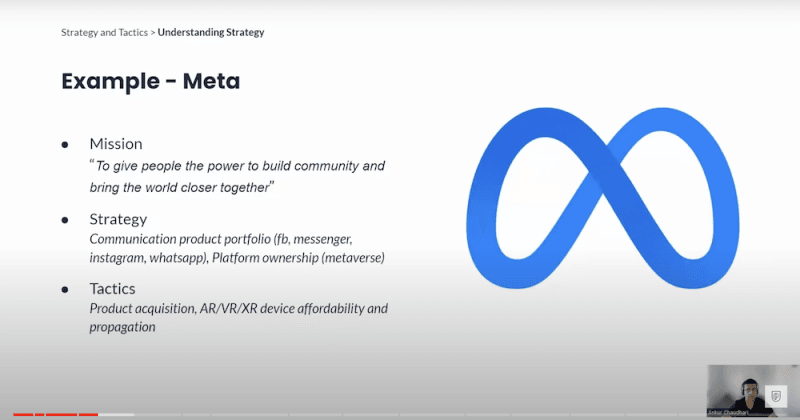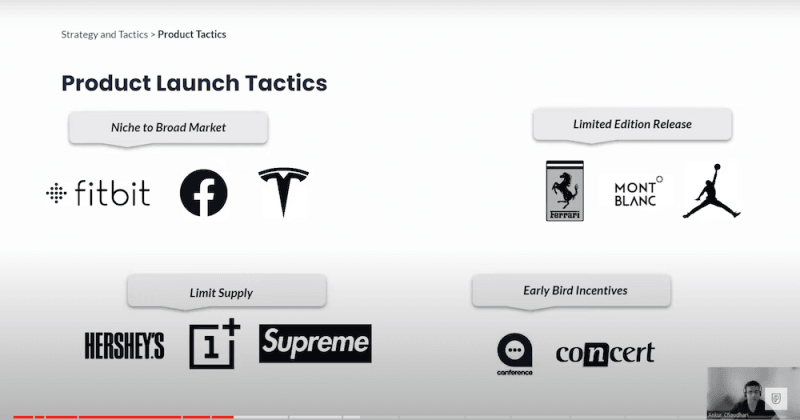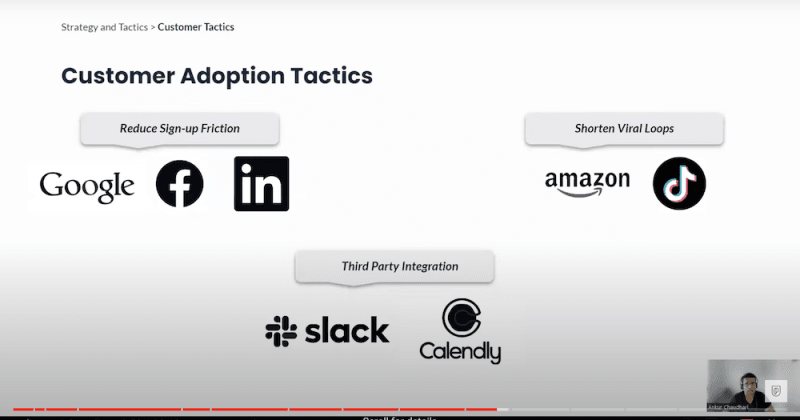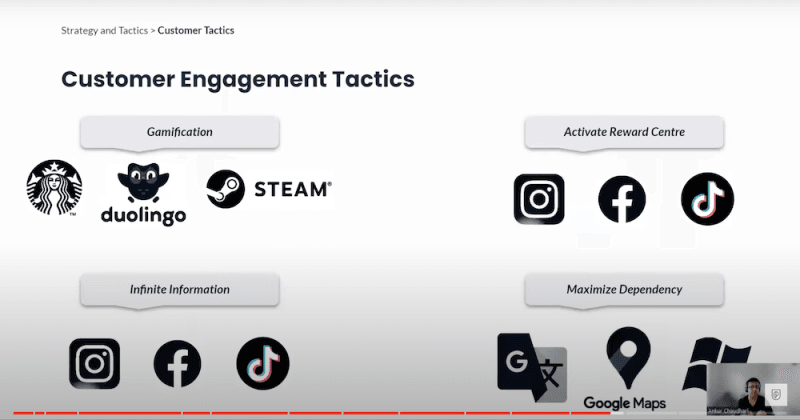Updated: July 1, 2024- 7 min read
Effective strategies and tactics are key to driving product success, but do you know the difference between the two? In this post, you’ll learn the difference between strategy vs tactics and discover real-world examples of how they’re applied at leading Silicon Valley companies to make better product decisions.
Editorial note: This post is based on a talk by Ankur Chaudhari, Senior Product Manager at Amazon, on Strategy vs Tactics in Product Management and contains additional insights and examples from the Product School team. You can watch the webinar in full below.
The strategy pyramid: a guiding framework
Let’s jump straight in. What’s the difference between strategy vs tactics?
Imagine a pyramid. At its apex is the mission—the “why” behind a company’s existence. Below it, you find the goals set to bring the mission to fruition, followed by strategies that define how these goals will be achieved. Next come the tactics, which are practical steps to implement the strategy. The pyramid's base is formed by operations, the processes utilized to execute tactics.

As a product manager, you'll operate across all these levels, with a particular emphasis on goals, strategies, and tactics.
Consider the missions of Airbnb and Meta. Airbnb aims to create a sense of belonging anywhere, aligning its product offerings with this mission. Meta, on the other hand, is driven by a mission to bring communities together. Their strategies reflect these unique missions.

Product lifecycle and strategy
Understanding a company's mission helps us comprehend its decision-making process but we also can’t forget the product lifecycle. The lifecycle stage of a product is key to determining the strategies that product managers should employ. This stage isn’t always easy to identify, as products often blur the boundaries between different lifecycle stages. Hence, product managers may need to combine different strategies to achieve their goals.
Take Netflix as an example. As its growth has recently slowed, it's tried various tactics, such as clamping down on account sharing and increasing subscription costs. However, these measures have provided only short-term boosts. They're now considering an ad-supported subscription tier to attract new customer segments and sustain growth.
It’s important to note that strategy isn't exclusive to products. It also applies to customers, competitors, sales, marketing, technology, people, and more. The product's context and its stage in the lifecycle determine the kind of strategies product managers need to employ. They may even need to blend different strategies, given that pinpointing a product's exact stage in its lifecycle is often tricky
Each strategy can have multiple tactics, and depending on the circumstances, a combination of these might yield the best results. Let's delve into these strategies and their corresponding tactics…
Unpacking tactics: launch, scaling, and sustenance
During a product launch, tactics like targeting a niche before going broad can be useful. This tactic, employed by Facebook, can start by targeting academia before expanding to other sectors. Limited edition and limited supply products can also build exclusivity and demand, driving sales despite high prices. Finally, early bird offers incentivize customers to buy products or services before launch, providing a financial cushion to deliver on promises.

Following product launch, the focus shifts to scaling. This can be achieved by parallelizing development into microservices, breaking down the product into independent components to increase efficiency. Additionally, economies of scale can help market leaders offer customers a wider selection and competitive prices. Cross-platform operability, exemplified by the integration of Microsoft Word and PowerPoint with numerous other apps, is another tactic for product scaling.
Once a product has matured, the challenge is to sustain it. Tactics such as data trapping, where user data is used to personalize the experience and tie users to the platform, can be useful for retention. Facebook and Spotify are good examples of this. Another strategy is to create new business lines, like Amazon's diversification into cloud services via Amazon Web Services. Lastly, adding additional service tiers, like Netflix's ad tier, can help maximize revenue and attract a broader market segment.
These tactics are integral to the product lifecycle, assisting with the successful launch, scaling, and sustenance of a product.
Beyond sustenance: tactics for product reinvention, customer adoption, growth, engagement, and retention
Let’s look at some of the common tactics used by leading Silicon Valley companies to achieve a wide range of goals.
Product reinvention tactics:
1. Broader Value Chain: Brands like Netflix, Steam, Google and iOS expanded their services to capture a broader industry opportunity.
2. Narrow Depth: Brands become so proficient in their services that they're synonymous with them, like Google and Xerox. A less common example would be specialized lasagna pasta sheet makers.
3. Sub Steps: Products that cater to very specific needs, like battery holders.
4. Casual: Brands like Metatronic attempt to dominate online social interactions, implying a reinvention.
Customer adoption tactics:
1. Reduce Sign-up Friction: Make sign-up process easier with services like Google, Facebook, and LinkedIn to avoid losing potential customers.
2. Sharpened Viral Loops: Simplify customer actions for smoother operation. Examples include Amazon's one-click purchasing function or sharing TikTok videos without needing to sign up.
3. Third-party Integration: Successful services like Slack and Calendly ensure compatibility with many other applications and platforms.

Customer growth tactics:
1. Importing Network Effects: Brands like Airbnb and LinkedIn grew by utilizing existing networks, like Craigslist listings or professional contacts.
2. Automation: Streamline processes for efficiency in conversion funnels, language translation, or development.
3. Marketing Strategy: Effective marketing can greatly boost customer growth, such as product features on shows like Shark Tank or Dragons Den.
Customer engagement tactics:
1. Personal Engagement through Gamification: Brands like Starbucks use points, premium services, and achievements to keep users engaged.
2. Activating the Reward Center: The "dopamine hit" from endless scrolling or waiting for the next photo or video to load.
3. Infinite Information: Similar to the reward center, applies to text articles and news.
4. Maximum Dependency on Product: Brands like Google Translate and Maps become indispensable due to their superior functionality.

Customer retention tactics:
1. Ownership of Digital Assets & Lifetime Data: Users often hold onto their accounts due to the valuable data or digital assets they've accumulated. Shopify, for example, benefits from users who won't close accounts with money still in them.
2. Maximizing Dependency: As previously discussed, making the product indispensable can drive both customer retention and engagement.
Strategy vs tactics: key takeaways
We can say that the main difference between strategy vs tactics is that strategies define how goals will be achieved, whereas tactics are the smaller, practical steps to implement the strategy. However, their definitions can change depending on perspective and goals. A strategy in one context could be a tactic in another. Don't fixate on strict definitions; rather focus on your North Star (major objective).
Remember that what works for one product might not work for another. An effective tactic for one brand may backfire for another. For instance, Instagram's attempt to become a content discovery platform like TikTok backfired due to the fundamental differences between the two platforms.
Don’t forget prioritization and constraints. As a product manager, it's essential to select the most impactful strategies based on your available resources and time. Prioritize those strategies and initiatives that deliver high impact and multiply your efforts.
As you’ve seen, mastering the balance and interplay of strategy and tactics in product management can pave the way for product success and customer satisfaction. As you move forward in your product management journey, remember the Strategy Pyramid and consider how your tactics support your strategies, and how these strategies align with your overall mission.
Learn more with Product School
Great PMs need to understand how to support a Product Strategy. But as you ascend the Product career ladder, you are responsible for owning that strategy, crafting it, and communicating it effectively.
To deepen your understanding of the latest product strategies, don’t miss out on our Product Leader Certification (PLC)®. Developed with top Silicon Valley Product Leaders, the (PLC)® will help you navigate your next major career transition by enhancing your leadership skills and owning product strategy. Schedule a call with our Admissions Team now to find out more.
Updated: July 1, 2024





